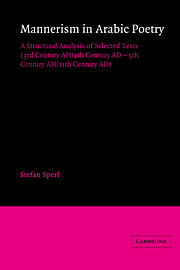 Mannerism in Arabic Poetry
Mannerism in Arabic Poetry Summary
The early Abbasid writer Abū l-‘Atāhiya was admired for his panegyrics and love poetry, but was most celebrated for his zuhdiyyāt (see Glossary). To the study of some of these, this chapter is devoted.
Like the panegyric qaṣīda, the zuhdiyya expresses a thematic canon from which every work of its type derives its elements. The canon of the zuhdiyya is somewhat more limited in scope, and the octastich cited in the appendix as text IV contains all the major themes of the genre. This poem is the main point of reference throughout the chapter, and I will refer to it as the Paradigm. The first three lines recall two aṭlāl/nasīb topoi discussed above. There is the word bahja which refers to beauty as it falls victim to the passing of time. In the panegyric on Mutawakkil, discussed in chapter two, Buhturī uses the same word in the same context:
yā dimnatan jādhabathā 1-rīḥu bahjatahā
tabītu tanshuruhā ṭawran wa-taṭwīhā
O campsite remnants whose beauty the wind vies to tear away
spending the night between concealing them and laying them bare.
The other is the topos of unity and division (jam‘ and tafrīq) which was found to be a structuring element in Buhturī's qaṣīda on Muhammad b. Yūsuf al-Thaghri (see above pp. 29f). Again, Fate is the divider, but here is intended not the separation of lovers but the separation caused by death. In the following three lines, the analogy with the panegyric poem seems to disappear. Where a madīḥ might have begun, where a sovereign might have been urged to restrict the painful workings of Fate, there is the praise of God and the admonishment of mankind. Many a madīḥ ends by voicing hopes for a future of prosperity and well-being under the sovereign.
- Type
- Chapter
- Information
- Mannerism in Arabic PoetryA Structural Analysis of Selected Texts (3rd Century AH/9th Century AD – 5th Century AH/11th Century AD), pp. 71 - 96Publisher: Cambridge University PressPrint publication year: 1989
